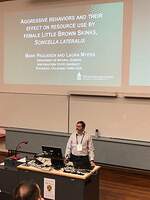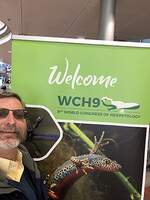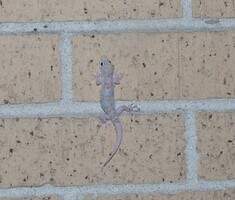Natural Sciences Department Faculty Research Mark Paulissen

Mark Paulissen presenting a talk at the Ninth World Congress of Herpetology meeting
at the University of Otago, Dunedin, New Zealand; January 10, 2020

Dr. Paulissen and a bearded dragon ("Zulu"):
a representative of the Iguania lineage of lizards. Photo taken by Dr. Tabatha Hibbs.
A Little Brown Skink in a spatial learning test: this one has been trained to escape to the retreat backed by the vertical stripes. Photo taken by Dr. Mark Paulissen.
Adult Little Brown Skink (Scincella lateralis) from northeastern Oklahoma. It is one of the smallest lizards that occurs in Oklahoma. Photo taken by Dr. Mark Paulissen.

A Mediterranean Gecko, Hemidactylus turcicus, from Louisiana. This lizards has been introduced into many states in the US, including Oklahoma. It is active at night on the sides of buildings where outside lights attract insects. Photo taken by Dr. Mark Paulissen.
Dr. Mark Paulissen
Ph.D. in Zoology
University of Oklahoma
Phone: 918-444-3816
Office: SC 139
Lab: Bioscience Research Facility
paulisse@nsuok.edu
Research interests
Recent Publications
Current Students
Student Research Presentations
Interesting Links
Herpetology Class Pictures Part 1.pdf
Herpetology Class Pictures Part 2.pdf
Research Interests
General research interest: behavior and ecology of reptiles and amphibians.
Dr. Paulissen and his students study lizard behavior and ecology. Recent work has focused on describing aggressive behaviors in skinks (family Scincidae), studying spatial learning in little brown skinks (Scincella lateralis), documenting the response of phrynosomatid lizards to predator odors, and analyzing the gut microbiota of lizards. He has also collaborated on numerous studies of the ecology of whiptail lizards (family Teiidae) and on demographic studies of the introduced Mediterranean gecko.
Specific projects include:
- evaluation of spatial learning in lizards,
- study of the role of sent in predator detection and avoidance in reptiles territoriality and aggressive behavior in skinks (a group of lizards found in Oklahoma),
- role of experience in influencing the outcomes of aggressive encounters in reptiles,
- effects of human impact on reptile and amphibian populations, and natural history of neonate and juvenile reptiles and amphibians (the life history stage upon which natural selection acts most dramatically).Studies are of diet, habitat selection, microhabitat use seasonal and daily activity periods, etc.
Recent Publications
Cole, C.J., H. C. Dessauer, M. A. Paulissen, and J. M. Walker. 2020. Hybridization Between Whiptail Lizards in Texas: Aspidoscelis laredoensis and A. gularis. American Museum Novitates. American Museum Novitates. 3947: 1-13.
Paulissen, M. A. and D. A Moran. 2017. Intraspecific aggression in neonate common Five-Lined Skinks (Plestiodon fasciatus). Journal of Herpetology 51:477-481.
Myers, L. and M. Paulissen. 2017. Aggressive behaviors and their effect on resource use by male little brown skinks, Scincella lateralis. Journal of North American Herpetology. 2017(1): 5-10.
Walker, J. M., J. E. Cordes, and M. A. Paulissen. 2016. Rare syntopy of the diploid parthenogenetic lizard (Aspidoscelis laredoensis B) and both gonochoristic progenitors (A. gularis and A. sexlineata) in Texas, USA. Herpetological Conservation and Biology. 11:29-39.
Paulissen, M. A. 2016. Dominance relationships in juvenile five-lined skinks (Plestiodon fasciatus): does small size matter? Proceedings of the Oklahoma Academy of Science 96: 119-120.
Paulissen, M. A. 2014. The role of visual cues in learning escape behavior in the little brown skink (Scincella lateralis). Behaviour 151 (2014) 2015-2028.
Paulissen, M.A., H.A. Meyer, and T.S. Hibbs. 2014. Growth rates of the Mediterranean gecko, Hemidactylus turcicus, in southwestern Louisiana. Western North American Nat. 74: 71-78.
Trauth,S.E., J. E. Cordes, M.A. Paulissen, and J.M. Walker. 2013. ASPIDOSCELIS LAREDOENSIS (Laredo Striped Whiptail) x ASPIDOSCELIS GULARIS (Texas Spotted Whiptail). DIFFERENTIAL RATE OF HYBRIDIZATION. SSAR Herpetology Rev. 44: 664-666.
Paulissen, M.A., H.A. Meyer, and T.S. Hibbs. 2013. Movement patterns and sociality of the Mediterranean gecko, Hemidactylus turcicus in southwestern Louisiana. Southwestern Naturalist. 58:344-350.
Becker, B. M. and M. A. Paulissen. 2012. Sexual dimorphism in head size in the little brown skink (Scincella lateralis). Herpetological Conservation and Biology. 7: 109-114.
Paulissen, M.A. 2011. Geographic variation in learning of escape behavior in the little brown skink (Scincella lateralis). Journal of Ethology 29:493-497.
Taylor, H.L., M.A. Paulissen, J.M. Walker, and J.E. Cordes. 2011. Food niche breadth and overlap between syntopic populations of the parthenogenetic Aspidoscelis tesselata pattern class C and gonochoristic Aspidoscelis sexlineata (Squamata: Teiidae) in southeastern Colorado. Southwestern Naturalist 56:180-186.
Montgomery, C.E., S.M. Boback, S. Green, M.A. Paulissen, and J. M. Walker. 2011. Cnemidophorus lemniscatus (Sauria: Teiidae) on Cayo Cochino Pequeno, Honduras: extent of island occupancy, behavior, diet, body size, reproduction, and conservation status. Herpetological Conservation and Biology 6: 10-24.
Current Students
Trey Pennington is a new graduate student beginning his work on a Master's of Natural Science. His project will center on comparing behaviors of urban versus natural populations of the Five-Lined Skink (Plestiodon fasciatus). This lizard is common in forests and woodlots of Oklahoma, but has also successfully colonized urban habitats (ex. The Tahlequah campus of NSU) whereas other local species of lizards have not been able to do so. Trey's research seeks to discover if the behavioral repertoire of Five-Lined Skinks somehow adapts them to colonize urban habitats.
Cameron Williams is an NSU Honor Student who has just started working with Dr. Paulissen. He is interested in the role of color preferences in the behavior of lizards. The Five-Lined Skink lizard (Plestiodon fasciatus) has a bright blue tail when it hatches and adult males develop intense orange coloration on their heads during the breeding season. Such coloration only makes sense if Five-Lined Skinks (1) can see color, and (2) if they have a preference for or aversion to color. Cameron's research seeks to determine if this is the case for neonate Five-Lined skinks.
Recent Students
Katie Fletcher is an NSU Honors Student studying the behavioral interactions on neonate Little Brown Skinks (Scincella lateralis). Previous work done by former NSU Honors student Laura Myers showed that adult male and adult female Little Brown Skinks react aggressively toward each other and avoid each other in staged encounters. Katie's study discovered that neonate Little Brown Skinks are not aggressive to each other at all and, unlike the adults, readily share retreats. Katie was named Outstanding Scholar for the College of Science and Health Professions at the 2020 NSU Undergraduate Research Day. Her presentation, as well as those of the other Outstanding Scholars, can be seen at about the 57 minute mark of the URD video: https://www.facebook.com/NSURiverHawks/videos/581408582484238/
Devyn Moran recently graduated with Honors from the NSU Biology program. She completed a research project that described the aggressive behavior of juvenile five-lined skinks when they encountered each other. Juveniles do not fight with each other the way adults do, but do behave aggressively using short charges and quick bites to assert dominance. Devyn's research was presented at the Oklahoma Academy of Science meeting in 2014 and was published in the Journal of Herpetology in 2017. Devyn recently graduated from the Oklahoma School of Optometry.
Rance Kingfisher graduated from NSU with a Master's of Natural Science in December 2019. His project was a study of the ability of the Prairie Lizard (known locally as the Fence Lizard: Sceloporus consobrinus) to detect and respond to the odors of one of its snake predators. Rance found that Prairie Lizards are not particularly sensitive to the odors of predatory versus non-predatory snakes. However, he did find that adult lizards exhibited a significantly greater number of odor detection behaviors than neonates, suggesting and ontogenetic component to odor detection behavior. Rance's research has been presented to the Indian Nations Audubon Society in 2019 and is scheduled to be present at the 2020 Oklahoma Research Day. Rance is presently an instructor at Rogers State University in Claremore, Oklahoma.
Student Research Presentations
Rebecca Gleason: Sceloporus consobrinus Digestive Tract Microbiota2018 NSU Undergraduate Research Day. THIRD PLACE for BEST POSTER.
Rance Kingfisher: Behavioral responses of adult and neonate Sceloporus consobrinus lizards to predatory odors. Oklahoma Research Day 2020. Weatherford, Oklahoma. POSTER.
Katie Easter: Epidemiological Factors Contributing to the Infection of Parasitic Jellyfish (Polypodium hydriforme) in Oklahoma Paddlefish (Polyodon spathula). NSU Undergraduate Research Day, Tahlequah, Oklahoma. POSTER. College of Science and Health Professions Outstanding Scholar
Katie Fletcher: Aggressive behavior of juvenile Little Brown Skinks (Scincella lateralis). NSU Undergraduate Research Day, Tahlequah, Oklahoma. College of Science and Health Professions
OUTSTANDING SCHOLAR. https://www.facebook.com/NSURiverHawks/videos/581408582484238/
Interesting Links
Center for North American Herpetology, Lists of Amphibians and Reptiles for all 50
states and the Canadian Provinces:
Herpetological Literature of Oklahoma: https://www.accessify.com/o/biosurvey.ou.edu
The Reptile Database: http://www.reptile-database.org/
Oklahomans for Excellence in Science Education: http://www.oklascience.org/
The National Center for Science Education: http://ncse.com/
Academically Adrift: https://psmag.com/education/what-happened-to-academic-rigor-27874
